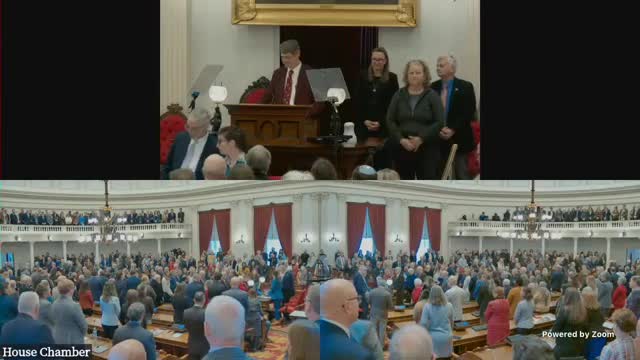Philip B. Scott sworn in as Vermont’s 82nd governor; joint assembly appoints escort committee
January 09, 2025 | SENATE, Committees, Legislative , Vermont
This article was created by AI summarizing key points discussed. AI makes mistakes, so for full details and context, please refer to the video of the full meeting. Please report any errors so we can fix them. Report an error »

Philip B. Scott was sworn in as governor of Vermont on Jan. 9 during a joint assembly of the Vermont Legislature. The oath was administered on the statehouse floor; the gathering included ceremonial music, clergy invocations, and the attendance of current and former statewide officials.
The assembly heard a reading directing the two houses to meet in joint assembly to receive the governor’s inaugural message. Early in the session a senator identified only as “the senator from Chittenden Central District” moved that a six‑member committee be appointed to wait upon the governor and escort him into the chamber. The motion was approved by voice vote: “The ayes have it and the motion is carried,” the chair said. The chair then named the committee members as the senator from Chittenden Central District (identified by the chair as Senator Behruth), the senator from Chittenden Southeast District (Senator Lyons), the senator from Caledonia District (Senator Beck), Representative Houghton, Representative McCoy of Essex Junction, and Representative Logan of Burlington.
Chief justice of the Vermont Supreme Court (named in the session) administered the oath of office to Philip B. Scott. The assembly also recorded the oath being administered to several other statewide officers during the ceremony, including the secretary of state and the attorney general. The event included multiple musical performances and invocations by clergy and a rabbi; ceremonial honors were given by the state police honor guard and members of the National Guard.
Later in the program the chair declared the joint assembly dissolved after the family of the governor and other dignitaries were escorted from the chamber.
Ending: The session was largely ceremonial. The governor used the address that followed the oath to outline policy priorities on housing, education and affordability for the coming legislative session.
The assembly heard a reading directing the two houses to meet in joint assembly to receive the governor’s inaugural message. Early in the session a senator identified only as “the senator from Chittenden Central District” moved that a six‑member committee be appointed to wait upon the governor and escort him into the chamber. The motion was approved by voice vote: “The ayes have it and the motion is carried,” the chair said. The chair then named the committee members as the senator from Chittenden Central District (identified by the chair as Senator Behruth), the senator from Chittenden Southeast District (Senator Lyons), the senator from Caledonia District (Senator Beck), Representative Houghton, Representative McCoy of Essex Junction, and Representative Logan of Burlington.
Chief justice of the Vermont Supreme Court (named in the session) administered the oath of office to Philip B. Scott. The assembly also recorded the oath being administered to several other statewide officers during the ceremony, including the secretary of state and the attorney general. The event included multiple musical performances and invocations by clergy and a rabbi; ceremonial honors were given by the state police honor guard and members of the National Guard.
Later in the program the chair declared the joint assembly dissolved after the family of the governor and other dignitaries were escorted from the chamber.
Ending: The session was largely ceremonial. The governor used the address that followed the oath to outline policy priorities on housing, education and affordability for the coming legislative session.
View full meeting
This article is based on a recent meeting—watch the full video and explore the complete transcript for deeper insights into the discussion.
View full meeting